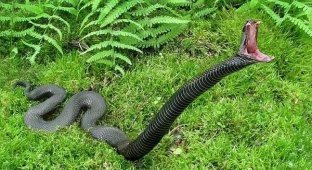The common viper (lat. Vipera berus) is a species of poisonous snake of the genus of true vipers of the viper family, often found in Europe and Asia.

Vipers are poisonous snakes (body length 60-80 cm, less often 1 m). Their bite, although painful, is not fatal. Unlike snakes, vipers have a pair of poison-conducting teeth in the upper jaw, through which the poison, produced and accumulated in special glands, enters the wound.

The common viper has an almost black zigzag stripe along its back (above the ridge); There is a sharp interception between the head and body, and a pattern in the form of the Latin letter x (x) is noticeable on the head. The pupils of the viper are slit-shaped (a nocturnal animal), while those of the common grass snake are round (a diurnal animal).

Common vipers are distributed throughout the forest zone. Typical habitats of vipers are swampy forests, clearings with good grass, clearings, overgrown burnt areas, banks of rivers and lakes, they are also found in vegetable gardens, less often in meadows, under haystacks.

On a hot sunny day, vipers warm themselves by lying motionless somewhere on an old stump or even on a well-trodden forest path; on cloudy and cool days they hide in shelters. At night they become active and hunt rodents and other animals. Sometimes vipers move to areas of the forest richer in food, swimming across rivers and lakes along the way.

The viper lies in wait for its prey and bites it (for example, a forest mouse), and then releases it in order to later find the corpse along the trail, since under the influence of the poison that penetrates the wound, the bitten animal quickly dies.

Vipers do not lay eggs. They remain in her body until the young are formed in them. At the end of summer, the so-called ovoviviparity occurs, in which the baby snakes (8-12 pieces) immediately after laying the eggs are freed from their shells and crawl away. Newborn vipers reach a length of 16.5 cm. As they grow, they molt, leaving behind crawling out like snakes.

Having transitioned to independent life, young vipers feed mainly on various insects, and later, becoming adults, they hunt mouse-like rodents, small birds, lizards, and frogs. In turn, vipers become victims of birds of prey and animals.

Vipers overwinter in the soil at a depth below the freezing layer, climbing into burrows of moles and rodents, passages of rotten roots of trees and shrubs, deep cracks in rocks and other shelters. Sometimes they accumulate in one place in small groups. Torpor in vipers during hibernation lasts in central Russia for about six months. Vipers live approximately 10-15 years.

By exterminating insect pests and mouse-like rodents in the forest, vipers are beneficial, so they should not be killed. They are afraid of a person and crawl away when he approaches, however, when walking through the forest, one must be careful not to step on or disturb a lying viper.

























